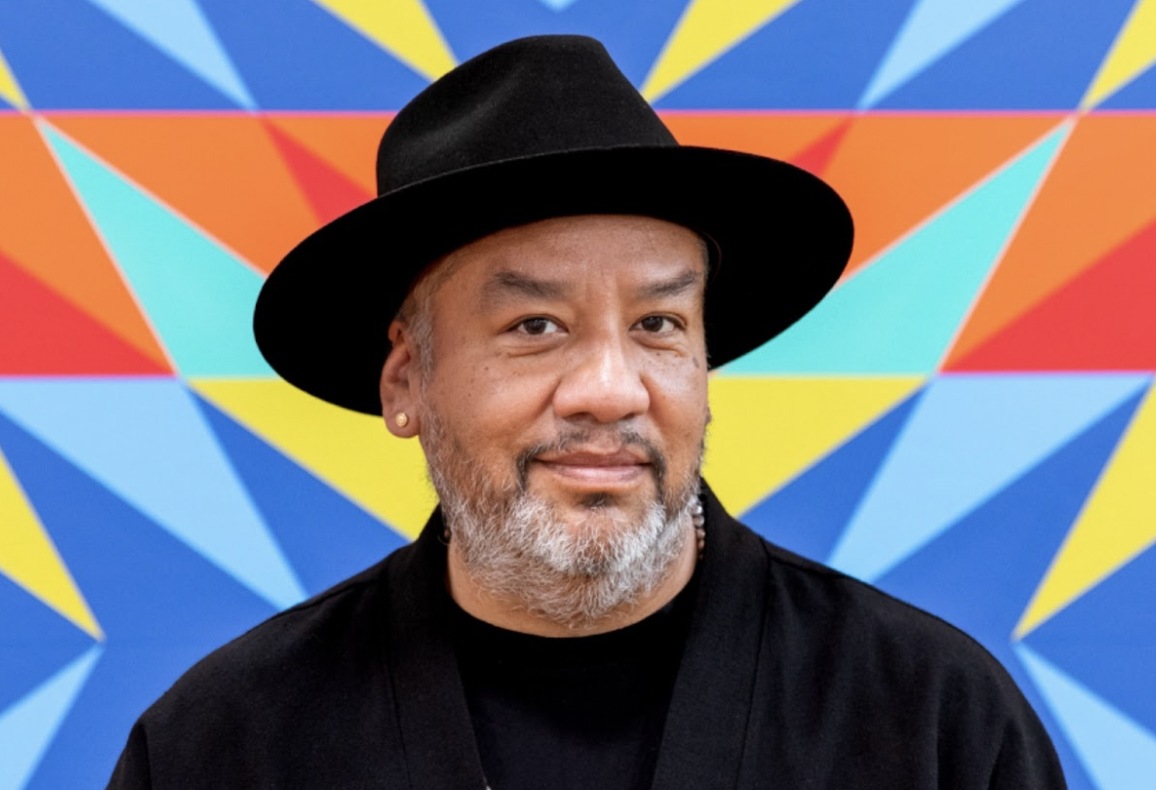
- Details
- By Kaili Berg
The Broad Museum in Los Angeles will open a new exhibition on May 10 featuring work by Jeffrey Gibson, the first Indigenous artist to represent the United States solo at the Venice Biennale.
The show, called "Jeffrey Gibson: the space in which to place me," will run through September 28, 2025, and features over 30 of Gibson’s vibrant and thought-provoking artworks.
Gibson, who is Choctaw and Cherokee, is known for mixing bright colors, geometric shapes, beads, and powerful messages in his art. His work often challenges the way history is told and celebrates Native identity, LGBTQ+ communities, and other groups that are often left out of the mainstream.
The title of the exhibit comes from a poem by Oglala Lakota writer Layli Long Soldier, which explores what it means to belong. That theme runs through the entire show, which includes paintings, sculptures, murals, flags, and a video installation.
One key artwork in the show is a large painting titled THE RETURNED MALE STUDENT FAR TOO FREQUENTLY GOES BACK TO THE RESERVATION AND FALLS INTO THE OLD CUSTOM OF LETTING HIS HAIR GROW LONG.
The title comes from a 1902 government letter telling Native students to cut their hair. Gibson uses the quote in a colorful, beaded artwork to turn a message of forced assimilation into a proud statement of resistance and cultural pride.
Another powerful moment in the exhibit pairs an old bronze statue called The Dying Indian with a pair of new beaded moccasins by artist John Little Sun Murie. The moccasins include lyrics from a Roberta Flack song and are meant to honor Native traditions while rethinking how history is remembered.
Throughout the show, Gibson draws from music, historical speeches, legal documents, and poetry. One mural includes lyrics from Nina Simone’s song Feeling Good, while a large sculpture spells out “WE WANT TO BE FREE” in beads, referring to early civil rights laws in the U.S.
The Broad has also added one of Gibson’s Venice Biennale paintings to its permanent collection.
“This show is about shining a light on stories that are often left out,” Gibson said. “It’s about joy, resistance, and showing that we belong.”
The museum will also host talks, performances, and workshops during the run of the exhibit to give people more ways to connect with Gibson’s work.
Gibson was born in Colorado in 1972. He studied painting in Chicago and London and now creates art that brings together Indigenous history, pop culture, and personal identity.
Jeffrey Gibson: the space in which to place me was first shown at the U.S. Pavilion at the 2024 Venice Biennale and is now coming to Los Angeles, with tickets available soon at thebroad.org.
More Stories Like This
Cherokee Nation Showcases Growing Film Slate with Fall Premieres of Incentive-Supported TitlesChickasaw Artists Represent at Southwestern Association for Indian Arts in Santa Fe
Zuni Partners Share Community-Led Delapna:we Project at ATALM 2025 Conference
Celebrating 50 Years: The Rockwell Museum Looks to the Future with "Native Now"
AMC Announces Return of Dark Winds for Season 4, Premiering February 15
Help us tell the stories that could save Native languages and food traditions
At a critical moment for Indian Country, Native News Online is embarking on our most ambitious reporting project yet: "Cultivating Culture," a three-year investigation into two forces shaping Native community survival—food sovereignty and language revitalization.
The devastating impact of COVID-19 accelerated the loss of Native elders and with them, irreplaceable cultural knowledge. Yet across tribal communities, innovative leaders are fighting back, reclaiming traditional food systems and breathing new life into Native languages. These aren't just cultural preservation efforts—they're powerful pathways to community health, healing, and resilience.
Our dedicated reporting team will spend three years documenting these stories through on-the-ground reporting in 18 tribal communities, producing over 200 in-depth stories, 18 podcast episodes, and multimedia content that amplifies Indigenous voices. We'll show policymakers, funders, and allies how cultural restoration directly impacts physical and mental wellness while celebrating successful models of sovereignty and self-determination.
This isn't corporate media parachuting into Indian Country for a quick story. This is sustained, relationship-based journalism by Native reporters who understand these communities. It's "Warrior Journalism"—fearless reporting that serves the 5.5 million readers who depend on us for news that mainstream media often ignores.
We need your help right now. While we've secured partial funding, we're still $450,000 short of our three-year budget. Our immediate goal is $25,000 this month to keep this critical work moving forward—funding reporter salaries, travel to remote communities, photography, and the deep reporting these stories deserve.
Every dollar directly supports Indigenous journalists telling Indigenous stories. Whether it's $5 or $50, your contribution ensures these vital narratives of resilience, innovation, and hope don't disappear into silence.
 The stakes couldn't be higher. Native languages are being lost at an alarming rate. Food insecurity plagues many tribal communities. But solutions are emerging, and these stories need to be told.
The stakes couldn't be higher. Native languages are being lost at an alarming rate. Food insecurity plagues many tribal communities. But solutions are emerging, and these stories need to be told.
Support independent Native journalism. Fund the stories that matter.
Levi Rickert (Potawatomi), Editor & Publisher

